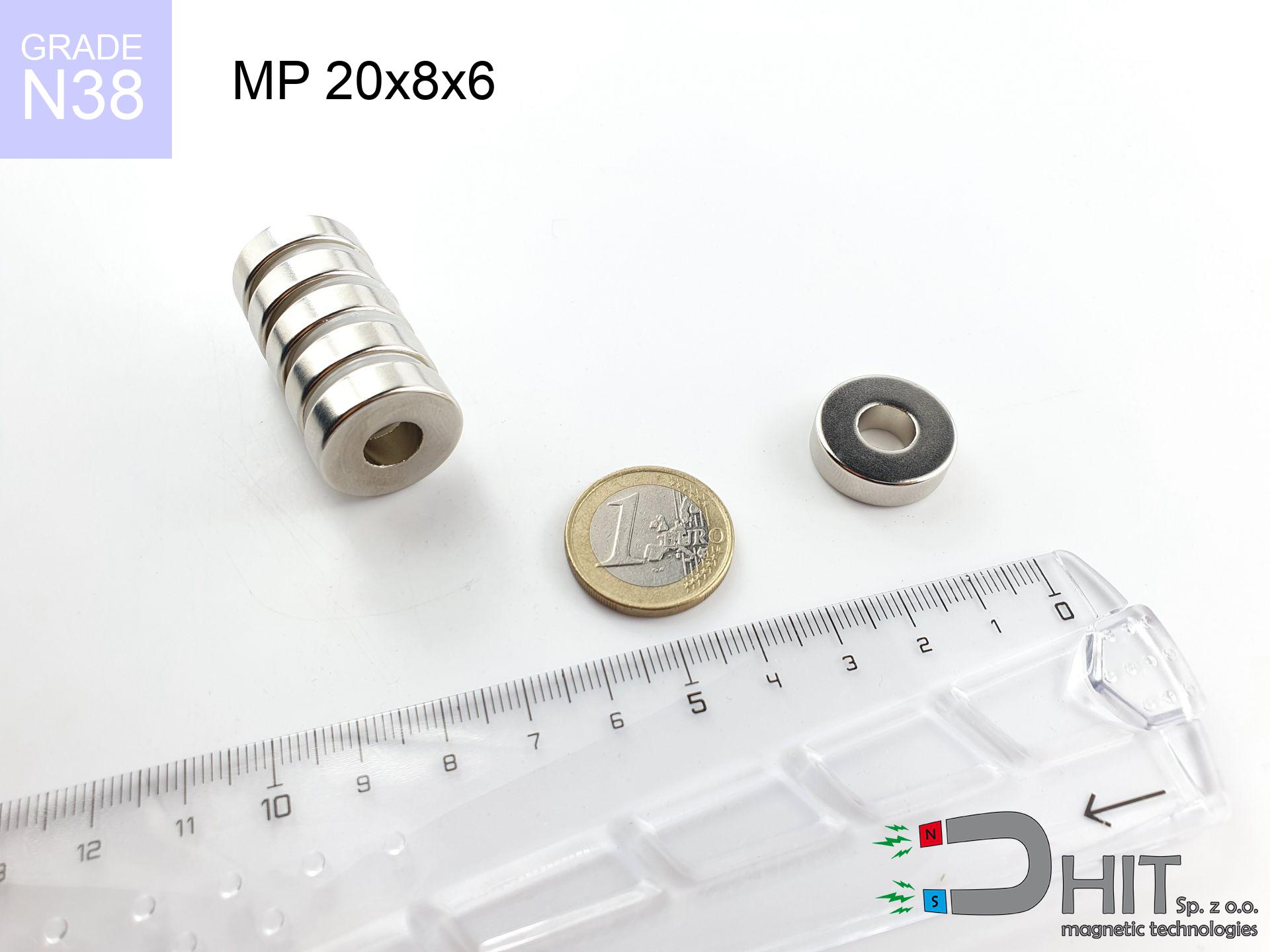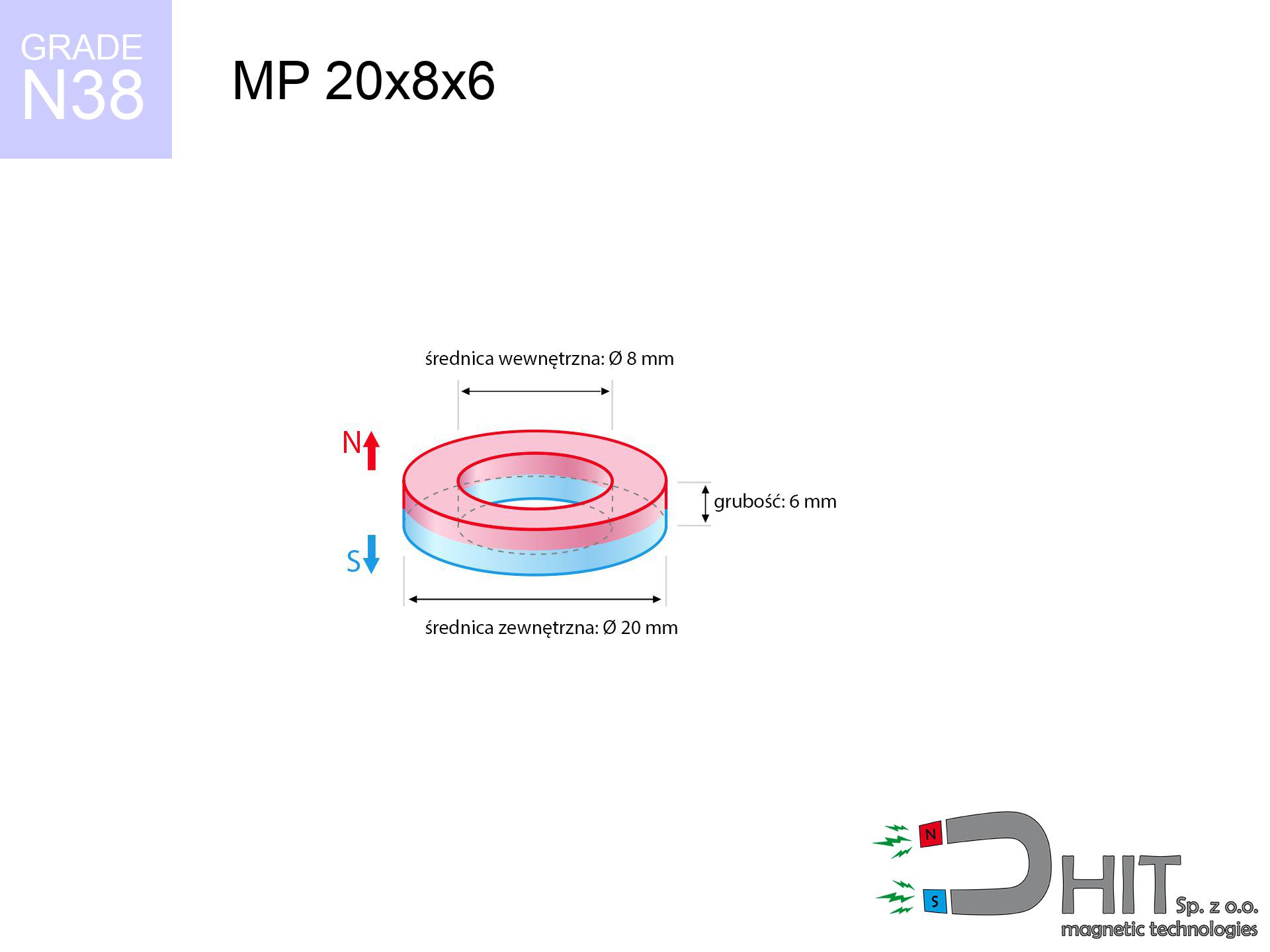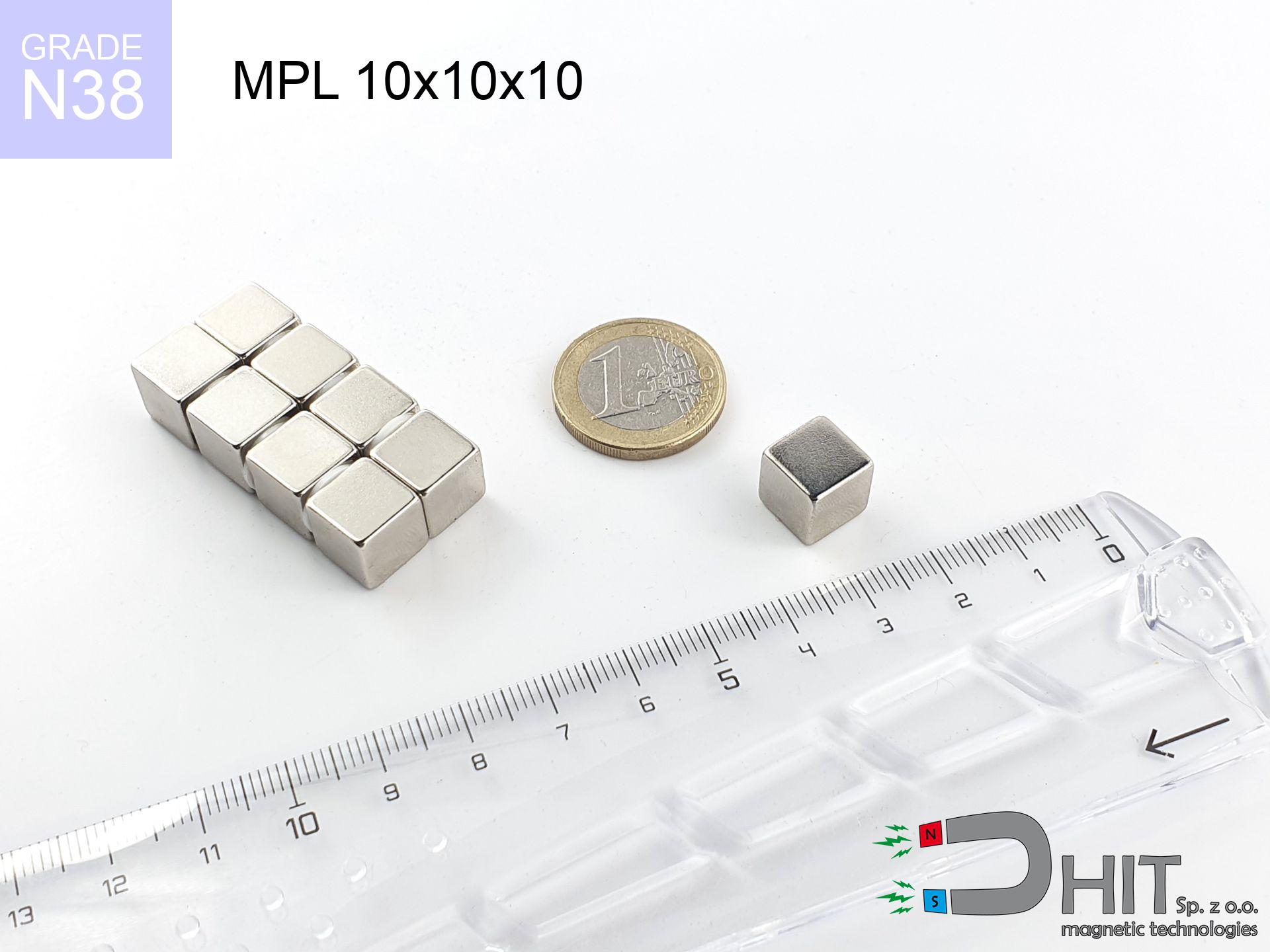MP 20x8x6 / N38 - neodymium magnet
ring magnet
catalog number 030189
GTIN: 5906301812067
external diameter Ø
20
mm [±0,1 mm]
internal diameter Ø
8
mm [±0,1 mm]
height
6
mm [±0,1 mm]
magnetizing direction
↑ axial
capacity ~
2.74 kg / 26.87 N
magnetic induction ~
196.23 mT / 1,962 Gs
max. temperature
≤ 80
°C
catalog number 030189
GTIN: 5906301812067
external diameter Ø
20 mm [±0,1 mm]
internal diameter Ø
8 mm [±0,1 mm]
height
6 mm [±0,1 mm]
magnetizing direction
↑ axial
capacity ~
2.74 kg / 26.87 N
magnetic induction ~
196.23 mT / 1,962 Gs
max. temperature
≤ 80 °C
5.17 ZŁ gross price (including VAT) / pcs +
4.20 ZŁ net price + 23% VAT / pcs
bulk discounts:
need more quantity?Want to bargain?
Call us tel: +48 888 99 98 98 or write via contact form on the contact page. You can check the power and the shape of neodymium magnet in our force calculator magnetic calculator
Orders placed by 2:00 PM will be shipped on the same business day.
Specification: ring magnet 20x8x6 / N38 ↑ axial
Magnetic properties of the material N38
Physical properties of sintered neodymium magnets Nd2Fe14B
List recommended items
Advantages as well as disadvantages of neodymium magnets NdFeB.
In addition to immense strength, neodymium magnets have the following advantages:
- They do not lose strength over time. After approximately 10 years, their strength decreases by only ~1% (theoretically),
- They are highly resistant to demagnetization by external magnetic field,
- By applying a shiny coating of nickel, gold, or silver, the element gains an aesthetic appearance,
- They exhibit extremely high magnetic induction on the surface of the magnet,
- By using an appropriate combination of materials, they can achieve high thermal resistance, allowing them to operate at temperatures up to 230°C and above...
- Thanks to the flexibility in shaping and the ability to adapt to specific requirements – neodymium magnets can be produced in a wide range of shapes and sizes, which expands the range of their possible uses.
- Significant importance in modern technologies – are utilized in hard drives, electric drive mechanisms, medical devices or various technologically advanced devices.
Disadvantages of neodymium magnets:
- They are fragile when subjected to a strong impact. If the magnets are exposed to impacts, we recommend using magnets in a metal holder. The steel housing in the form of a holder protects the magnet from impacts, and at the same time increases its overall strength,
- Magnets lose their power due to exposure to high temperatures. In most cases, when the temperature exceeds 80°C, these magnets experience permanent reduction in strength (although it is worth noting that this is dependent on the form and size of the magnet). To avoid this problem, we offer special magnets marked with the [AH] symbol, which exhibit high temperature resistance. They can operate even at temperatures as high as 230°C or more,
- Magnets exposed to a humid environment can corrode. Therefore, when using them outdoors, we recommend using waterproof magnets made of rubber, plastic, or other moisture-resistant materials,
- Limited ability to create threads or complex shapes in the magnet - the use of a housing is recommended - magnetic holder
- Potential hazard associated with microscopic parts of magnets can be dangerous, if swallowed, which is particularly important in the context of children's health. Additionally, miniscule components of these magnets can hinder the diagnostic process when they are in the body.
Handle with Care: Neodymium Magnets
Magnets should not be treated as toys. Therefore, it is not recommended for youngest children to have access to them.
Neodymium magnets are not toys. You cannot allow them to become toys for children. Small magnets pose a serious choking hazard or can attract to each other in the intestines. In such cases, the only solution is to undergo surgery to remove the magnets, and otherwise, it can even lead to death.
Neodymium magnets can demagnetize at high temperatures.
While Neodymium magnets can demagnetize at high temperatures, it's important to note that the extent of this effect can vary based on factors such as the magnet's material, shape, and intended application.
Neodymium magnets are over 10 times more powerful than ferrite magnets (the ones in speakers), and their power can shock you.
To use magnets properly, it is best to familiarize yourself with our information beforehand. This will help you avoid significant harm to your body and the magnets themselves.
Neodymium magnets are noted for being fragile, which can cause them to become damaged.
Neodymium magnets are highly delicate, and by joining them in an uncontrolled manner, they will break. Magnets made of neodymium are made of metal and coated with a shiny nickel, but they are not as durable as steel. At the moment of connection between the magnets, small metal fragments can be dispersed in different directions.
Dust and powder from neodymium magnets are flammable.
Do not attempt to drill into neodymium magnets. Mechanical processing is also not recommended. Once crushed into fine powder or dust, this material becomes highly flammable.
Neodymium magnets can attract to each other, pinch the skin, and cause significant swellings.
Magnets attract each other within a distance of several to around 10 cm from each other. Remember not to place fingers between magnets or alternatively in their path when they attract. Magnets, depending on their size, can even cut off a finger or alternatively there can be a serious pressure or even a fracture.
Neodymium magnets should not be near people with pacemakers.
Neodymium magnets generate strong magnetic fields. As a result, they interfere with the operation of a pacemaker. This happens because such devices have a function to deactivate them in a magnetic field.
You should keep neodymium magnets at a safe distance from the wallet, computer, and TV.
Strong magnetic fields emitted by neodymium magnets can destroy magnetic storage media such as floppy disks, credit cards, magnetic ID cards, cassette tapes, video tapes, or other devices. In addition, they can damage televisions, VCRs, computer monitors, and CRT displays. You should especially avoid placing neodymium magnets near electronic devices.
The magnet is coated with nickel. Therefore, exercise caution if you have an allergy.
Studies show a small percentage of people have allergies to certain metals, including nickel. An allergic reaction often manifests as skin redness and rash. If you have a nickel allergy, try wearing gloves or avoid direct contact with nickel-plated neodymium magnets.
Avoid bringing neodymium magnets close to a phone or GPS.
Magnetic fields can interfere with compasses and magnetometers used in aviation and maritime navigation, as well as internal compasses of smartphones and GPS devices. There are neodymium magnets in every smartphone, for example, in the microphone and speakers.
To illustrate why neodymium magnets are so dangerous, see the article - How dangerous are very strong neodymium magnets?.





![rubber magnetic holder external thread 66x8.5 [M8] GZ / N38 rubber magnetic holder external thread 66x8.5 [M8] GZ / N38](https://cdn3.dhit.pl/graphics/products/umggz-66x8.5-m6-gz-gas.jpg)


